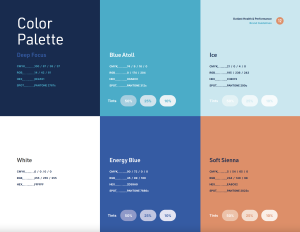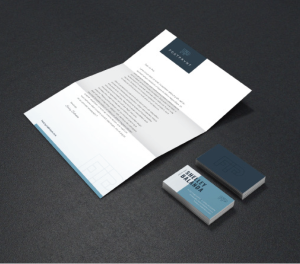The Importance of Brand Guidelines: Crafting a Consistent and Memorable Identity
Nov 16, 2023
Admittedly, we at Stout Heart are brand purists. We believe that establishing a strong and recognizable brand is essential for business success. While a brand cannot fix a bad product, it certainly can make or break the future of a good one. One key tool that facilitates this process is the creation and adherence to brand guidelines. Whether you’re a startup or a well-established corporation, understanding what brand guidelines are and recognizing their importance can significantly impact your brand’s identity and perception.
Defining Brand Guidelines
The number of folks who want a logo without a brand guideline document is surprising. Why? In short, a logo on its own does not a brand make. The logo mark is just that, a mark. And while it may be the most important piece of the branding puzzle, it cannot fully do its job without the supporting elements that are clearly outlined in a brand guideline document.
Brand guidelines, also known as brand style guides or brand manuals, are comprehensive documents that provide a set of rules and standards for how a brand should be presented to the world. These guidelines encompass a wide range of elements, including the visual aspects (such as logo usage, color palette, and typography), messaging tone, and even the overall brand philosophy. They serve as a blueprint for maintaining consistency across all communication channels, both internal and external.
Smaller businesses often employ a scaled-down version of a brand guideline called a brand board. these are generally a one-pager and cover the most basic of branding requirements (logo versions, basic color palette, primary and secondary font use). While we don’t typically recommend this as an alternative to a proper brand guideline document, we will occasionally help clients with limited budgets out by creating one as a way to ensure that we’re never sending a logo out into the world on its own.
Consistency Is Key
One of the primary reasons brand guidelines are crucial is the emphasis they place on consistency. A consistent brand image builds trust and recognition among your audience. When customers encounter a brand that maintains a cohesive and uniform appearance across various platforms, it fosters a sense of reliability and professionalism. The opposite, a brand that is not governed by unified brand standards, risks losing consumer trust because of what inconsistency tacitly communicates.
Consistency extends beyond just visual elements. It also applies to the language and messaging used by the brand. Whether it’s a social media post, a print advertisement, or a company blog, maintaining a consistent tone and voice strengthens the brand’s personality and helps it resonate with the target audience.
Building Recognition and Trust
Brand guidelines play a pivotal role in creating a recognizable brand identity. A distinctive logo, a unique color scheme, and a specific font choice all contribute to the visual elements that set a brand apart. When consumers encounter these elements repeatedly, they begin to associate them with the brand, fostering recognition. Over time, this recognition transforms into trust, a vital component in consumer decision-making.
A brand that consistently presents itself in a clear and coherent manner is more likely to be remembered by its audience. This memorability is crucial in a world saturated with information and choices. A strong brand identity ensures that, amidst the noise, your brand stands out and remains top-of-mind for potential customers.
Efficiency in Communication and Design
Internally, brand guidelines serve as a valuable resource for employees, designers, and marketers. They provide a framework for creating marketing materials, ensuring that everyone involved is on the same page regarding the brand’s visual and messaging standards. This not only streamlines the design process but also reduces the likelihood of inconsistencies that could dilute the brand’s impact.
Efficiency in communication extends beyond design. A well-defined set of guidelines helps teams articulate the brand’s values, mission, and vision consistently. This clarity is especially valuable for large organizations with diverse teams working on different projects.
Adaptability and Growth
As businesses evolve and expand, so too must their brand guidelines. An effective set of guidelines is adaptable, providing room for growth and change while maintaining the core identity of the brand. This flexibility ensures that the brand remains relevant in an ever-changing market and can seamlessly incorporate new elements without compromising its integrity.
What Should Be Included in a Brand Guideline Document?
It’s important to remember that no brand is the same so there should be no cookie-cutter approach to brand guidelines. The items below are meant to be a loose framework, not the law of the brand gods.
1. Brand Overview:Start your brand guideline document with a brief but impactful overview of your brand. Define your mission, vision, and values. This section sets the tone for the entire document, offering readers a clear understanding of the essence and purpose of your brand. This might look like a single page or several, depending on how you choose to break the information up.

Example of logo clear space outlined in a brand guideline document for Roster
2. Logo Usage: Your logo is the face of your brand. Detail its proper usage, specifying size, placement, and acceptable color variations. Include clear space guidelines for minimum size requirements to maintain visibility and legibility across different mediums. Ever heard of the term “clear space”? If you’re a branding nerd, the answer is yes.
Make sure you’re careful to note how much space should be left as a buffer around your logo when it’s used in context. We all hate the smorgasbord of logos you see smushed together when an organization lists a bunch of sponsor’s together. Clear space is the best way to ensure that your logo never gets lost in the crowd so make sure it’s addressed in those brand guidelines.
Additionally, it’s important to include a minimum logo size, keeping in mind that when you shrink a logo down for digital use it can distort or obscure what it’s meant to be. Thing about what your logo might look like in favicon form. Can you tell what it is? Will it make sense to the consumer?
Another important logo usage challenge to address in your brand guidelines is how a logo is used on top of a photo versus a solid color background. It should always pop and never get lost and it’s your brand guidelines’ job to ensure that.

Example of color palette from brand guidelines done for Outlast Health & Performance
3. Color Palette: A consistent color palette is integral to brand recognition. Specify primary and secondary colors, along with their Pantone, RGB, and CMYK values. Provide guidance on where and how each color should be used to maintain a cohesive visual identity. If you want to be extra thorough, give careful thoughtto digital- what colors should be used for hover states and hyperlinks, etc. We like extra thorough. Remember that the person creating the brand guidelines will not be the only one to use them. Make sure you spell out as much as possible.
4. Typography: Define the fonts and typefaces that represent your brand. Specify font families for headings, subheadings, and body text. Include guidance on font sizes, line spacing, and any additional styling rules to ensure a consistent and professional appearance. And don’t forget to be clear about when and where each font should be used.
5. Imagery and Photography: Establish guidelines for the style and types of images that align with your brand. This may include preferred subjects, image composition, and any specific editing filters or treatments. Consistent imagery contributes to a unified brand aesthetic.
6. Voice and Tone: Clearly articulate the personality of your brand through voice and tone guidelines. Define the appropriate language style for different communication channels, ensuring a consistent and recognizable brand voice across all interactions.
7. Messaging and Copywriting: Provide examples of preferred messaging and communication styles. This section of your brand guidelines should include guidelines for taglines, slogans, and key messages that resonate with your brand’s identity and values.
8. Iconography and Graphic Elements: If your brand incorporates specific icons or graphic elements, outline their usage rules. Specify when and where these elements should be employed to maintain a cohesive visual language. We see this most frequently with brands that offer multiple services- be sure to outline why and how those icons should be used.

Sample of letterhead and business card templates created for Footprynt Advisors
9. Stationery and Collateral: If you can, include templates and guidelines for business cards, letterheads, and any other stationery or collateral materials. This ensures that all branded materials maintain a consistent and professional appearance and also provides future designers with an idea of how the brand should look in the wild.
Never forget that your brand might need something unique and while brand guidelines are meant to unify a brand, they should not hinder it. If you find that your brand guideline document isn’t hitting, it may be time to consider a brand refresh or redesign (for more on this, check out our blog post on which is which and how to know if you need them).
In conclusion, brand guidelines are a cornerstone of successful branding strategies. They provide a roadmap for creating a consistent, memorable, and trustworthy brand identity. By adhering to these guidelines, businesses can build stronger connections with their audience, foster brand loyalty, and navigate the competitive landscape with confidence. As the saying goes, “a well-defined brand is a promise kept.”
To learn more about Stout Heart’s branding work, check out our portfolio. Like what you see? Get in touch! We’d love to chat.